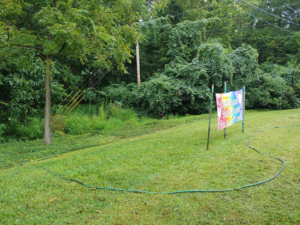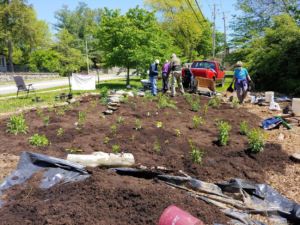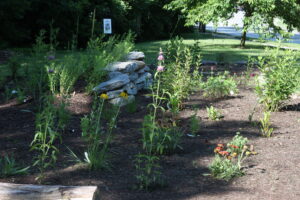
In April of 2020, just as the pandemic was sweeping our continent and the world, the Unitarian Universalist Church of Lexington applied for a grant from our local Wild Ones chapter to install a new wildflower garden. The grant requirements were that the garden must be visible to the public and use native plants to support native pollinators. We felt we had the perfect mission and location to meet these requirements. UUCL has a strong commitment to the interconnected web of life and a long history of planting trees, shrubs, and flowers to attract both humans and wildlife. We own seven+ acres of property on Clays Mill Road, with a stream at the bottom of the hill near the road and a backdrop of mature trees on the other side of the creek. In May 2020, we were delighted to be awarded a grant of $500 to install a new native plant garden between the creek and Clays Mill Road.
Well, we do not recommend starting such a project in the height of a pandemic. Faced with difficulties getting people together to plan and prep the site, it took a bit longer than we expected. In preparation for the work ahead, we went to Tina’s Plants-N-Such to learn about installing new flowerbeds on an existing grass/lawn area, discussed how large to make our area, and talked with local native plant vendors about plant recommendations and availability for our location.
We finally got the site lined out in late August, sheared the existing grass off, covered everything with cardboard and then had a local tree service dump a load of wood chips onto the cardboard in October. As we were spreading the wood chips around, we realized that they were contaminated with winter creeper vine and seeds. Well, if there is one thing UUCL has, it is lots of winter creeper and we did not need any more. We covered the whole area with heavy black plastic and let it rest over the winter.

While we waited for Spring, Linda Porter worked with Tina Elliott to create a plant list and site design. Having a good design was important to help us plan our budget and determine what plants could be donated by UUCL and Wild Ones instead of purchased. We also took that time to find something that could serve as a hardscape feature at the site.
In March of 2021, we pulled back the plastic and began moving the wood chips toward an area of the creek bank which was already covered with winter creeper. We had treated this area with herbicide and covered with heavy cardboard before we loaded the wood chips on top. Once the chips had been removed from our planting bed, we found nets of thin roots at the soil surface that may have been a grass, or something else, ready to send up shoots. Those were removed along with the chips. After more clearing of weeds, the fun began. In between workdays the planting bed was kept covered with the plastic to prevent spring seeds from dispersing onto our bare area.

On April 22, Earth Day, we began installation for real. First, we built a wall. Finding a hardscape feature turned out to be too expensive but, luckily, we were having other grounds work done by Russ Turpin of EcoGro. They delivered 9 cubic yards of limestone rocks that we used to make a feature wall in the center of the garden. We filled in behind this wall with a scoop of topsoil to allow new plants to be elevated above the wall and seen from the road. We were ready to plant.
Planting took place on May 7 when we installed over 90 plants. Some were purchased from Tina’s Plants-N-Such and Eartheim Design, and some donated by our church gardening team. We mulched with living mulch and the whole thing was completed in about 4 hours by 10 people working steadily throughout the morning. A labor of love and a wonderful ending to a challenging and beautiful project!
Susan Cohn
